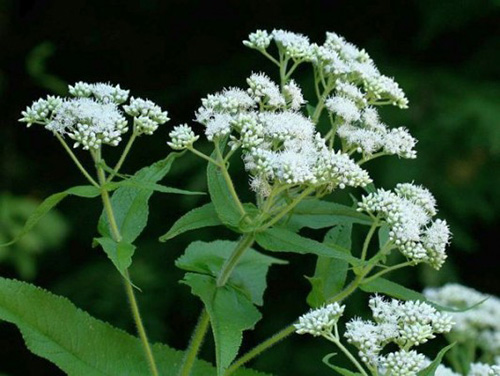Contents
Traditional medicine and herbal remedies contain countless plants used for centuries to treat various ailments. Among these botanical treasures stands out the Boneset plant (Eupatorium perfoliatum), also known as thoroughwort or feverwort. Native American tribes revered this incredible herb due to its therapeutic properties. With such a long history in North America, this remarkable plant has become highly regarded in the medical community.

The Boneset Plant – A Brief Introduction
Boneset is a herbaceous plant belonging to the Asteraceae family. It can grow in damp environments such as marshes, wet meadows, or stream banks. Its scientific name, “perfoliatum,” refers to how its leaves appear connected through their stems – giving it an intriguing appearance. This perennial species typically grows upwards of two feet tall with delicate white tubular flowers arranged into clusters for added visual appeal. Native North American plants like boneset have been used medicinally by native peoples since ancient times due to their potent healing properties. Today modern science has confirmed many traditional uses for this valuable botanical ally!
- Parts Used: Tops.
- Properties: Diaphoretic, stimulant, antipyretic, laxative.
- What it Affects: Stomach, Liver, Intestines, and Circulation
Historical Medicinal Uses

Iroquois tribes, which are various indigenous communities, including the Mohawk, Oneida, Onondaga, Cayuga, and Seneca, have used the Boneset plant for medicinal purposes. These tribes recognized its healing properties and used it extensively to treat various illnesses.
One common application was reducing fever, which is why it became known as “feverwort.” Additionally, due to its expectorant and diaphoretic effects, this herb proved helpful in alleviating respiratory conditions such as colds, flu, or bronchitis. Its legacy continues today, with many people still using it for these same benefits.
The indigenous peoples of America had long been aware of the healing properties of the boneset plant. They passed on this knowledge to early settlers. By the 18th century, folk healers and physicians across North America widely used boneset as an herbal remedy. Its popularity continued into the following century due in part to its effectiveness. Today, we continue to explore ways traditional medicine can complement modern medical practices for the best health outcomes.
The Health Benefits of Boneset
The Boneset plant’s historical use in traditional medicine continues to attract attention from both enthusiasts and modern researchers alike. Let us explore some fascinating facts about this remarkable plant’s diverse health advantages:
Fever Reduction and Immune Support
Boneset has long been recognized for supporting the immune system during infections while reducing fevers. The plant’s active compounds, such as alkaloids and flavonoids, stimulate sweating, which helps cool down your body temperature by eliminating unwanted substances from within it. This diaphoretic property is beneficial when dealing with colds, flu, or other infectious diseases that cause high temperatures. Furthermore, the boneset’s immunostimulant effects boost our body’s defense mechanisms against pathogens so we can fight off illnesses more effectively.
Respiratory Relief
Boneset is a powerful ally in addressing respiratory issues due to its expectorant properties. Promoting the expulsion of mucus and phlegm helps clear congested airways, relieving coughs, bronchitis, or other related discomforts. Its soothing nature also eases irritation within the throat and lungs, making it an excellent natural remedy for those suffering from such conditions. If you’re looking for a safe yet effective way to alleviate your symptoms without taking medications, consider trying boneset!
Anti-Inflammatory Properties
Inflammation is a common underlying factor in many health issues; fortunately, boneset offers relief through its potent anti-inflammatory properties. Sesquiterpene lactones – known for their ability to mitigate inflammation throughout the body – make this herb an excellent choice when managing conditions such as arthritis or other discomforts caused by chronic inflammation. With regular use, you may find that incorporating boneset into your daily routine can help alleviate symptoms and promote overall wellness.
Digestive Aid
Boneset has been used as a digestive tonic for centuries due to its bitter components that stimulate secretions in the stomach. This promotes healthy digestion and helps break down food more efficiently, relieving indigestion, bloating, or other discomforts related to poor digestion. Moreover, improved nutrient absorption is often seen when one takes boneset regularly, contributing to overall gut wellness. It’s no wonder why this herb remains popular even today!
Mild Pain Relief

For those seeking a natural alternative to over-the-counter pain medications, boneset may relieve minor discomforts such as headaches or body aches associated with fever or inflammation. Its mild analgesic properties make it an attractive option for individuals who prefer gentler remedies when dealing with these issues. Try this herbal approach if you want something different from traditional pharmaceutical options.
Common Cold and Flu Support
Boneset is a versatile herb that can alleviate common colds and influenza symptoms. Its fever reduction, immune-boosting, and respiratory-relieving properties make it an ideal choice for natural remedies during illness. With this powerful plant on hand, you’ll have peace of mind knowing that effective options are available without resorting to traditional medications.
Administration and Precautions
This popular herbal remedy includes dried leaves for tea infusions, tinctures, capsules, and extracts. However, before using this plant-based medicine, it’s essential to exercise caution. As with any natural treatment, it’s always best to consult an experienced healthcare professional before incorporating boneset into your wellness routine—especially if you’re pregnant or breastfeeding while simultaneously taking prescription medications.
Conservation and Sustainable Harvesting – A Balancing Act
The Boneset plant is a valuable medicinal herb that requires responsible harvesting practices to ensure its survival in the wild. Cultivating this plant on sustainable farms or gardens can also help conserve it while reducing pressure on natural populations. We can preserve this vital resource for future generations by adopting these measures.
Boneset Plant – Potential Side Effects
Like any herbal remedy, potential side effects may be associated with its use. While the therapeutic benefits are numerous responsible decision-making and informed usage are critical in avoiding adverse reactions. Some of these possible negative outcomes include:
- Digestive Issues: While the boneset has been known for its digestive benefits due to its bitter constituents, some individuals may experience gastrointestinal discomfort. Consuming large amounts or using them over an extended period could lead to nausea, vomiting, and diarrhea.
- Allergic Reactions: Allergic reactions to boneset use could manifest as skin rashes, hives, or swelling. Suppose you have known sensitivities towards plants belonging to the Asteraceae family, such as ragweed daisies and marigolds. In that case, it’s advisable not to use boneset without consulting your healthcare provider first.
- Liver Toxicity: Boneset is a plant-based remedy that contains pyrrolizidine alkaloids – natural compounds found in several families of plants. While these substances may offer therapeutic benefits when consumed properly, they can also pose significant risks if taken excessively or over an extended period. Prolonged use at high doses could potentially lead to liver damage; therefore, it’s essential not only to follow recommended guidelines for usage but also to avoid using boneset altogether should you have any pre-existing conditions affecting your liver health.
- Interaction with Medications: Boneset may interfere with certain medications leading to unwanted outcomes or reduced effectiveness. If you are taking prescription drugs that undergo liver metabolism, consult a healthcare professional before using boneset, as potential interactions could be at play. Take caution and prioritize your safety by seeking expert advice on this matter.
- Not Recommended for Pregnant or Nursing Women: Boneset is not recommended for pregnant or nursing women because it can stimulate uterine contractions. This could pose a risk during both stages of motherhood. Therefore these individuals must avoid using this herb until they have consulted with their healthcare provider about any potential risks associated with doing so.
- Central Nervous System Effects: Central nervous system disturbances may occur, leading to dizziness, confusion, or tremors. To avoid these adverse reactions, it’s crucial not to overuse boneset.
- Photosensitivity: Boneset consumption or contact can trigger increased sensitivity to sunlight (photosensitivity) in specific individuals. This heightened vulnerability could result in an elevated risk of sunburns when exposed to direct UV rays during the herb’s use. Therefore, such people must take necessary precautions outdoors during this time frame.
Things To Consider
Even though this herb has been known for its medicinal properties since ancient times, consulting with a qualified medical professional is essential before incorporating it into your health regimen, especially if you have underlying conditions or are taking prescription drugs. Pregnant and nursing women should avoid using boneset altogether as potential risks may be involved. Always follow recommended dosages and durations to minimize any side effects from misuse of this herb.
As more attention is given to herbal remedies today, the importance of incorporating them responsibly into our overall healthcare routine cannot be overstated enough. While plants like boneset offer many benefits, they should always be cautiously approached under professional guidance.
WARNING: Long-term use can result in toxicity.
Preparation and Dosage
- Infusion: Steep for five to fifteen minutes and take 3 ounces three times daily.
- Tincture: Take 10 to 40 drops three times daily.
- Fluid Extract: Take ½ to one teaspoon three times daily.
- Powder: Take 4 to 10 #0 capsules (20 to 60 grains) thrice daily.
Health Disclaimer: The information on this website is for educational uses only and is not a substitute for professional medical advice. Always consult an authorized healthcare provider for any health concerns before using any herbal or natural remedy. We do not establish, treat, cure, or prevent any disease. Reliance on any material from this website is solely at your own risk. We are not responsible for any adverse effects resulting from the use of information or products mentioned on this website.
REFERENCES
- Vance Ferrell Harold M. Cherne, M.D. The Natural Remedies Encyclopedia [Book]. – Altamont, TN: Harvestime Books, 2010. – Vol. Seventh Edition: 7: pp. 147. [ Boneset plant]
- National Institutes of Health (NIH): https://nccih.nih.gov
- PubMed: https://pubmed.ncbi.nlm.nih.gov
- The American Botanical Council: https://abc.herbalgram.org
